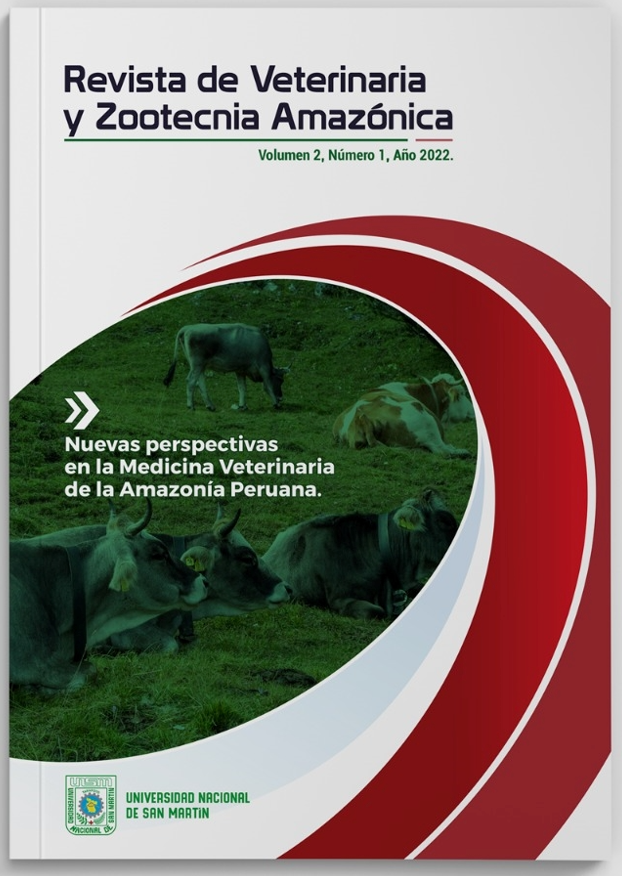Effect of effective microorganisms (me), in the rearing of nile tilapia
DOI:
https://doi.org/10.51252/revza.v2i1.307Keywords:
effective microorganisms, feed conversion, ponds, tilapiaAbstract
The nilotic tilapia fingerlings were reared at the Miraflores Agricultural Center, 3000 tilapia units were raised, these in a general pond and then they were distributed in three ponds, making a total of 1 000 tilapia per ponds, the stocking density was 4 tilapias / m2. The food was based on a commercial product whose diet was twice a day, this was for all treatments. A completely randomized design was used, the duration of the experiment was 120 days, the treatments were as follows; Pond 1 (control), Pond 2 (EM in water), Pond 3 (EM in food), the feeding was based on a commercial product, in the case of Pond 3, the commercial product plus EM were added. 5% of the pond population was evaluated, which are 50 tilapia, the biomass and feed conversion evaluations were made weekly, having 16 evaluations. The results were analyzed in each variable using the test of means and standard deviation, variance. The water quality in ponds 1 and 2 was improved with the use of efficient microorganisms, taking into account the best parameter in turbidity, dissolved oxygen, pH and ammonia reduction. The use of the water resource in ponds 2 and 3 was greater, which gave us superior parameters to the pond. The use of efficient microorganisms (EM) reduced pathogenic microorganisms by up to 88% in pond 2 and by 53% in pond 3.
Downloads
References
Cullis, S. & Pauly, D. Marine protected área costs as “beneficial” fisheries subsidies: A global evaluation. Coastal Management, 2010;38(2),113-121. https://doi.org/10.1080/08920751003633086
Food and agricultura organization of the united nations [FAO]. El estado mundial de la pesca y la acuicultura. Contribución a la seguridad alimentaria y la nutrición para todos. Roma, Italia: FAO, 2016.
Avnimelech, Y. Biofloc Technology: a pratical guide book. 2 ed. Lousiana, USA: World Aquaculture Society, 2012.
Luna, M. A. & Mesa, J. R. Microorganismos eficientes y sus beneficios para los agricultores. Revista científica Agroecosistemas, 2016;4 (2), 31-40. https://aes.ucf.edu.cu/index.php/aes/article/view/84
Melgar, C. Evaluación de la tecnología EM en granjas acuícolas comerciales en Tabasco, México. Universidad Juárez Autónoma de Tabasco, Tabasco, México, 2012.
Moya, J. Cómo hacer microorganismos eficientes. N°4 [Folleto]. Costa Rica: Ministerio de Agricultura y Ganadería, Dirección Regional Central Occidental, 2012.
Ladino, G. & Rodríguez, J. Efecto de Lactobacillus casei, Saccharomyces cerevisiae, Rhodopseudomona palustris (microorganismos eficientes em) y melaza en la ganancia de peso de tilapias (Oreochromis sp) en condiciones de laboratorio. Revista Orinoquia, 2009;13 (1), 31-39. https://www.imbiomed.com.mx/articulo.php?id=61868
Mohamed, A.; Mohamed, B.; Amr, F. and Samar, E. Responses of dietary supplementation of probiotic effective microorganisms (EMs) in Oreochromis niloticus on growth, hematological, intestinal histopathological, and antiparasitic activities. Aquaculture International, 2020;28, 947-963. https://doi.org/10.1007/s10499-019-00505-z
Suresh, A.V. Tilapia update 1999. World Aquacult., 2000;31(4): 16-58.
Cruz, E.M. & M.T. Ridha. Growth and survival rates of Nile tilapia (Oreochromis niloticus) L. juveniles reared in a recirculating system, fed with floating and sinking pellets. Asian Fish. Sci., 2001;14: 9-16. https://doi.org/10.33997/j.afs.2001.14.1.002
Abo-State, H.A., A.M. Tahoun & Y.A. Hammouda. Effect of replacement of soybean meal by DDGS combined with commercial phytase on Nile Tilapia (Oreochromis niloticus) fingerling growth performance and feed utilization. American Eurasian J. Agric. Environ. Sci., 2009;5(4): 473-479.
Castro, R.R., G.J. Hernández & B.G. Aguilar. Evaluación del crecimiento de alevines de tres especies de tilapia (Oreochromis sp.) en aguas duras, en la región de la Cañada, Oaxaca, México. Rev. Aquat., 2004;20: 38-43. http://www.revistaaquatic.com/ojs/index.php/aquatic/article/view/245
Botello, A.L., T.M.C. Viana, M.V.L. Cisneros, M.N. Valdivié, E.P. Ariza, E.T.G. Girón, G.S. Silvera, Y.R. Valera, M.E. Cutido, O.M. Miranda, I.A. Gómez, A.R. Botello & J. Guerra. La harina de caña proteica como alimento local en la producción de tilapia roja (Oreochromis spp.). REDVET, 2011;12(6): 1-10.
Llanes, J., J. Toledo & J.L. Vega. Tecnología de producción de alimentos semi-húmedo a base de ensilados de residuos pesqueros en la alimentación de tilapia roja (Oreochromis mossambicus x O. niloticus). REDVET, 2007;8: 1-6.
Ruiz, V.A.J.M., V.R. Tapia, P.J.R. García & V.H. González. Evaluación de un cultivo semiIntensivo de tilapia (Oreochromis niloticus) en tanques circulares con aguas termales. REDVET, 2006;7(11): 1-12.
Ross, L.G. Environmental physiology and energetics. In: M.C.M. Beveridge & B.J. McAndrew (eds.). Tilapias: biology and exploitation, fish and fisheries. Series 25, Kluwer Academic Publishers, Dordrecht, 2000;89-128.
Popma, T. & M. Masser.Tilapia life history and biology. Southern Regional Aquaculture Center (SRAC), Publication 283, USA, 1999;4 pp. https://appliedecology.cals.ncsu.edu/wp-content/uploads/283.pdf
Muñoz, G. & M. Garduño. Comparación del crecimiento entre Oreochromis niloticus, O. mossambicus y su híbrido bajo condiciones de cultivo. Vet. Méx., 1994;25(4): 323-326. https://pesquisa.bvsalud.org/portal/resource/pt/lil-187990
Published
How to Cite
Issue
Section
License
Copyright (c) 2022 Orlando Ríos-Ramírez, Lionel Bardales-del-Aguila

This work is licensed under a Creative Commons Attribution 4.0 International License.
The authors retain their rights:
a. The authors retain their trademark and patent rights, as well as any process or procedure described in the article.
b. The authors retain the right to share, copy, distribute, execute and publicly communicate the article published in the Revista de Veterinaria y Zootecnia Amazónica (REVZA) (for example, place it in an institutional repository or publish it in a book), with an acknowledgment of its initial publication in the REVZA.
c. Authors retain the right to make a subsequent publication of their work, to use the article or any part of it (for example: a compilation of their works, notes for conferences, thesis, or for a book), provided that they indicate the source of publication (authors of the work, journal, volume, number and date).


